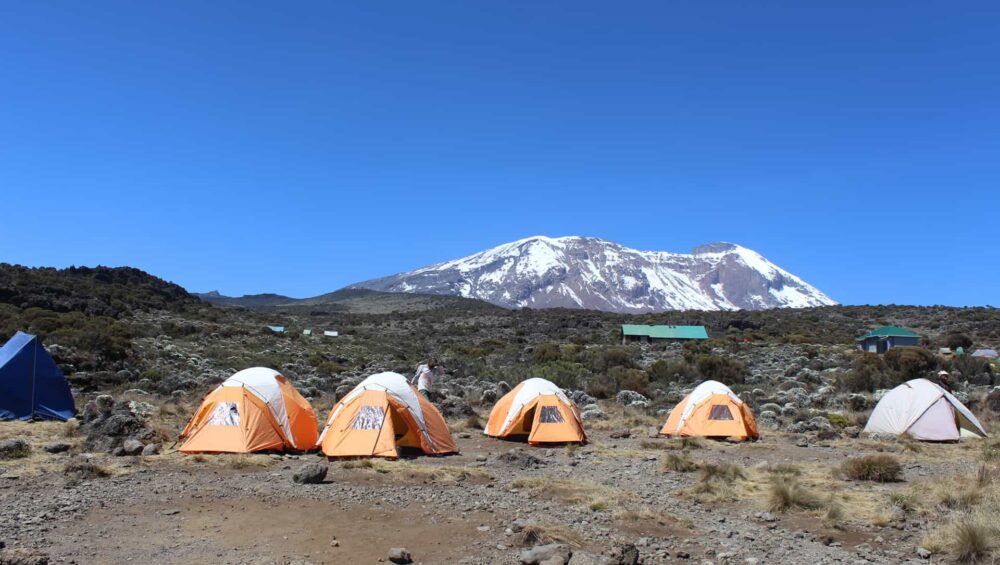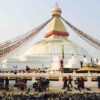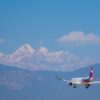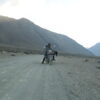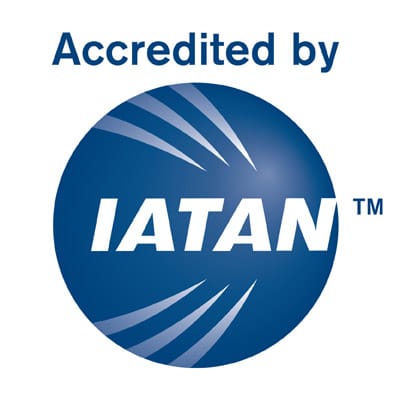ACCOMMODATION OPTIONS WHEN CLIMBING MOUNT KILIMANJARO
When you climb Mount Kilimanjaro, accommodation is unlike anything you may have experienced. Kilimanjaro Accommodation Options are either tents or mountain huts.
There is something truly special about just being out there in a tropical landscape, soaking in all of the sounds of the night on the mountain, which gives you one of the best feelings in the world.
There are times when getting a good night’s sleep is naturally more difficult on Kilimanjaro. This is particularly the case when you reach the high-altitude zones.
The good news is that with a little bit of foresight and knowledge beforehand, you can make your accommodation more comfortable during your climb.
However, it is also worth noting that the type of accommodation available will depend upon the route you take.
So, the Nature Horizons team wants to make sure you have all the information you need to choose the best accommodation.
You can also find more general tips and information about how to plan your perfect trip to Kilimanjaro.
Where to Sleep On Kilimanjaro?
Kilimanjaro Accommodation Options
Where to sleep on Mount Kilimanjaro depends on your hiking route and climbing package.
Kilimanjaro accommodation options are not much! You don’t have a lot of selections!
On All except the Kilimanjaro Marangu Route, you will sleep in tents at designated campsites.
Nature Horizons’ Tanzania team will organize your sleeping tents and mattress, whereby the quality of the tents ranges from mid-range to luxury walk-in-size tents with proper frame beds.
The Marangu Route offers shared hut accommodation with dormitory-style bunk beds. This means you will have a firm roof but it also reduces your level of privacy.
High-quality tents may feel more luxurious and comfortable than the Marangu Huts
What are the facilities on the Marangu Route Like?
All hiking routes on Mount Kilimanjaro are roughly similar in terms of facilities, or lack thereof. You will sleep in designated campsites with basic public toilet facilities.
There are flush toilets and running water at lower altitudes, but only long drop toilets at higher altitudes and no toilets along the path.
Only the Kilimanjaro Marangu Route offers accommodation in huts and some more facilities, but they are not necessarily more comfortable than the other routes.
For a more comfortable experience, just contact us and we will arrange the best package with private toilets, Mess dining tents with tables and chairs.
For more VIP Kilimanjaro Experience, Nature Horizons expands Kilimanjaro Accommodation Options as we can add luxuries such as a walk-in tent with frame beds, a portable mountain shower, or even a comfortable lounge tent with a heart to your climbing package.
Less popular routes such as Kilimanjaro Northern Circuit, Kilimanjaro Umbwe Route or Kilimanjaro Rongai Route may also feel more comfortable as you will get to enjoy more privacy, quiet campsites and unspoiled wilderness.
What is the accommodation on the Marangu Route like?
Marangu Kilimanjaro Accommodation Options
The Kilimanjaro Marangu Route is the only route with hut accommodation. This includes 60 bunk beds each at the Mandara and Kibo Huts and 120 bunk beds at Horombo Hut.
The Marangu Hut offers dormitory-style accommodation of between 4-20 bunk beds per room. It is not possible to rent a private room. Moreover, the allocation of beds is on a first-come-first-served basis. Therefore, expect to be sharing your hut with strangers.
However, it is worth noting that the huts do not come with mattresses and pillows. Nature Horizons tours team provides that. You’ll need to bring your own sleeping bags or rent from our Nature Horizons gears office in Moshi.
The first hut you will stay in will be the Mandara A-Frame Huts, which include solar lighting, flushable toilets, and piped water.
What are the tents on Kilimanjaro Like?
If you are not planning to take the Kilimanjaro Marangu Route, then your next question may be what are the tents on Kilimanjaro Like?
This really depends on the type of tents that you get for your trip.
For example, if you are on a standard tour, tents are generally smaller and more confined than you would get on a VIP tour on Kilimanjaro. You will need a sleeping bag, as cots are not included in a standard Kilimanjaro hiking tour.
Is it Worth getting a cot?
This leads us on to a second point: Is it worth getting a cot on Kilimanjaro?
Few can deny the comfort and luxury of a cot and walk-in tent. But should you invest in one? Much of this depends on what your preferences and accommodation requirements are.
How many people will I need to share my tent with on a standard Kilimanjaro hiking tour?
Standard tents are usually shared if you don’t have other arrangements. Nature Horizons team can arrange a private standard tent on Kilimanjaro just for you with some extra cost.
Unless otherwise stated, 1 or 2 people will share a 3-4-person tent, with plenty of space for you and your gear. But please note that high-grade tents designed to cope with extreme conditions don’t allow much room to stand up and walk around in your Kilimanjaro tent.
Sleeping alone or getting a walk-in-tent may incur an additional cost. If you consider this accommodation option, please specify this in email or WhatsApp chat.
What are the campsites like on Kilimanjaro?
All routes on Kilimanjaro use specifically designated campsites. Most campsites have a registration office and basic toilet facilities. They are safe, provide a good way to meet fellow climbers, and almost always have spectacular views. Your meals will be provided by the Nature Horizons team in a separate mess tent where you will be able to sit comfortably.
Apart from the Kilimanjaro Marangu Route, there are no shops on Kilimanjaro. Furthermore, there are no charging facilities and there is no heating (except for luxurious offers that can be upgraded to include a mess tent heater).
Few Kilimanjaro Campsites have running water, and there are no water sources near the base camps at high altitudes.

